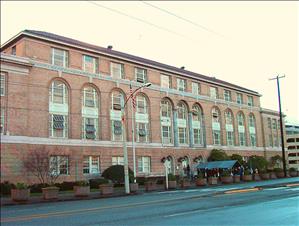The U.S. Immigration and Naturalization Service (INS) Building at 815 Airport Way S is sold on April 11, 2008, for $4.4 million in an online auction to INS Holdings LLC, a group of Seattle-area developers, attorneys, contractors, and architects. The decaying building has been a political football as activists in the nearby Chinatown-International District (ID) parry a succession of governmental efforts to resurrect the building as a work-release facility or jail.
Ellis Island of the Northwest
The four-story, yellow-brick, 77,000-square-foot building, known officially as the U.S. Immigrant Station and Assay Office, was designed in 1929 and opened in 1932. The general contractor was Elvind Anderson of Tacoma, who bid $517,880 for the job. The building replaced the outgrown immigration station at the foot of Union Street, between Western and 1st avenues. The Assay Office, created for the Klondike Gold Rush in the late 1890s, also moved to the Airport Way building; the Assay Office closed in 1955.
Both the old and new immigration stations were the region's Ellis Island. The Union Street detention center was racially segregated, with dormitory spaces for women, men, and boys. The early immigrants were overwhelmingly Asian, mostly Chinese males held under the Chinese Exclusion Act of 1882 (and subsequent revisions), which severely limited Chinese immigration and the rights of those few who were admitted. The ancestors of many International District residents passed through the Union Street building. In 1916, the INS processed some 900,000 immigrants there. During World War II, most of the detainees were Europeans unable to be deported to their homelands -- about 130 of them.
Among the notables temporarily sequestered in the Airport Way INS Building was Alvin "Creepy" Karpis (1907-1979), a 1930s gangster and member of the notorious Ma Barker Gang. Karpis, captured in 1936, was imprisoned in Alcatraz, where he spent 26 years before being transferred to the McNeil Island Penitentiary in Puget Sound. He was paroled in 1969 and held pending deportation to his native Canada. Karpis died on Spain's Costa del Sol at age 70, apparently of an accidental overdose of sleeping pills.
Visions and Revisions
By 1979, much of the Airport Way detention center had been converted to office space, and the INS began considering up-to-date accommodations. Others had their own visions for the building's future. King County Executive John Spellman (1926-2018), saddled with overcrowded jail and detention facilities, proposed converting the building into a work-release center with up to 300 residents. The outraged ID community, perceiving itself as the region's dumping ground, protested vehemently. King County Councilwoman Ruby Chow (1920-2008) made a much-publicized trip to the office of Senator Warren G. Magnuson (1905-1989) in Washington, D.C., and the proposal was effectively shot down.
A year later, the U.S. Justice Department announced plans to convert the building's top floor into a minimum-security prison. This time, King County and the City of Seattle joined the ID in rejecting the plan.
The building was extensively remodeled in 1987, but its INS service was approaching the end. In 2002, the INS was absorbed into the newly formed U.S. Department of Homeland Security. A new, 500-bed detention center was completed in Tacoma in 2004, and the Seattle INS Building has since been vacant, except for the occasional use of its basement as a homeless shelter.
Several entities, public and private, coveted the venerable building. The Chinatown-International District Preservation and Development Authority (PDA) wanted it for affordable housing and retail space. The Department of Veterans Affairs, private developers, the Salvation Army, and the Highline School District expressed varying levels of interest. A Seattle development firm, Urban Visions, had its own community housing plan and the City of Seattle tried to broker a deal. But the cost of asbestos removal and renovation -- $20 million or more -- ultimately thwarted all dreams. The building also is on the National Register of Historic Places, which limits what owners can do to it.
Everyone Came Through
"What we want to do is to get this building back into the fabric of the community," said Cihan Anisoglu, a Bainbridge Island architect and partner. "We're going to respect and enhance the historical aspect" (Wong).
Anisoglu said later: "It's a beautiful building, extremely well-built. Mediterranean Revival or something like that, with beautiful ornamentation. Because of the economic climate [in 2009], we're looking at alternative financing. We're working with the ID community on some joint projects on the history of immigration in the building, linking it to the community ... Almost everyone in the ID, or their relatives, came through this building" (Chesley interview).

